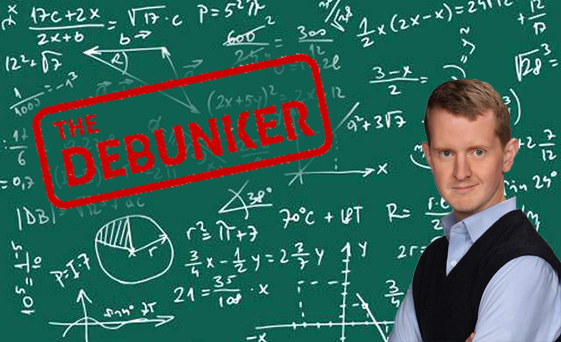
April has been Mathematics Awareness Month since 1999, making this the nineteenth time it's been observed. Wait, that's not right. The twentieth time. To celebrate our mathematical awareness, or lack thereof, Ken Jennings of Jeopardy! will be with us all month debunking all the popular misinformation about numbers that you thought once you could count on.
The Debunker: How Much Less is .9999… than One?
Like me, you may remember the first time you were asked to perform long division on two numbers that produced a repeating quotient. Do you recall the dreary, slowly dawning realization that these numbers were going to keep repeating in that pattern indefinitely? Even a respectable, friendly, familiar fraction like one-third turned out to be unending in its decimal expansion: 0.333333333333… We were taught to just put a horizontal line over the digit(s) that repeated and call it a day, but it sure wasn’t very satisfying.
-----
But the trouble really starts with .9 repeating: a decimal point followed by an endless string of nines. All levels of students, even including most undergraduate math majors, generally understand that this number is extremely close to 1—"infinitely close," some will allow—but still slightly less. After all, how could 0.999… be the same as 1.0? One begins with a zero and the other with a one. That difference in how they're expressed must reflect some tiny gap between them.
In fact, it's pretty easy to demonstrate intuitively using arithmetic that .9 repeating is exactly equal to 1, not slightly less. If .333… is one-third, and .666… is two-thirds, then obviously .999… is three-thirds, which is to say one, not a number slightly smaller than one. A more formal proof relies on the Archimedean property, which holds that the real numbers have no infinitely large or infinitely small elements, and is a little more involved but still fairly elementary. So why does our intuition insist that there must be a difference between .9 repeating and 1? Way down deep, apparently many of us still expect that .9999999 must stop somewhere; we have a hard time grappling with an endless series of nines. Or we incorrectly think of the series of nines as a process that is advanced as we do our long division, or zoom in on a number line. But that's not how limits work. 0.999999999… isn't infinitely nearing one as we reveal more digits of accuracy. It's already there.
Quick Quiz: Which actor has been Emmy-nominated three times for his role on Brooklyn Nine-Nine?
Ken Jennings is the author of eleven books, most recently his Junior Genius Guides, Because I Said So!, and Maphead. He's also the proud owner of an underwhelming Bag o' Crap. Follow him at ken-jennings.com or on Twitter as @KenJennings.

